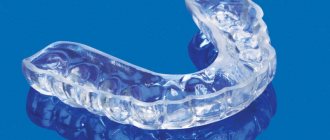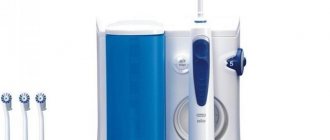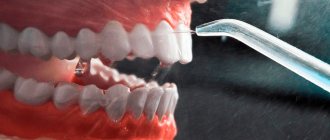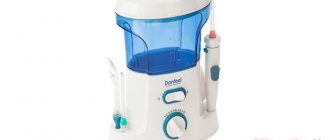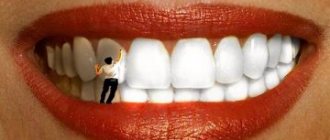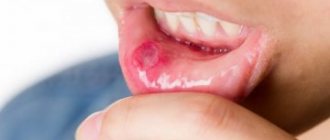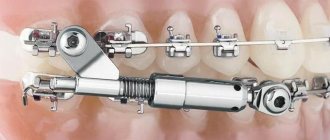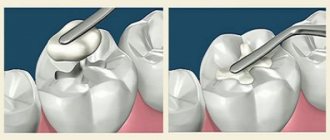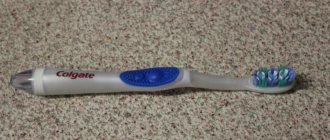Publication date: 11/18/2021
A regular or electric toothbrush, toothpaste, floss - a list of hygiene products and items that everyone uses when brushing their teeth. However, to improve these indicators, especially for patients undergoing orthodontic treatment (with braces), in the presence of crowns and dentures, veneers and implants, irrigators are recommended. Why do you need an oral irrigator and how to choose one? The dentists of the Axioma Dental clinic will help you with this issue.
Why do you need an irrigator?
- For the prevention of caries. The irrigator helps get rid of plaque on the teeth and tongue. It also cleans hard-to-reach areas such as molars, wisdom teeth, interdental spaces and orthodontic appliances.
- For the prevention and treatment of gum diseases. The irrigator improves blood circulation and accelerates regeneration processes. This helps strengthen the gums and reduce bleeding.
- For the care of implants, crowns, bridges, braces and other structures. The irrigator washes them and the cavities underneath them.
- To eliminate the cause of bad breath - bacterial plaque.
- For the prevention of gingivitis. The disease can occur in pregnant and lactating women due to deterioration of blood supply to the mucous membranes.
There are no contraindications to using the irrigator.
How to brush your teeth with an irrigator - step-by-step instructions
- Fill the reservoir with water or a special liquid at a comfortable temperature.
- Select the desired nozzle and install it on the handle of the device.
- Adjust the jet pressure.
- Place the nozzle in your mouth and press it lightly with your lips, then turn on the device.
- Lean over the sink and open your mouth slightly to allow the water to flow into the sink after cleaning.
- Direct the jet towards the teeth at a 90 degree angle. Dentists recommend this cleaning scheme: divide the entire jaw into four parts and treat them one by one. For example, first the upper left part is processed, then the upper right, then you can move on to the lower jaw using the same principle.
- When moving from one tooth to another, you need to stop at the interdental spaces, because Small pieces of food often remain between them and bacterial plaque accumulates.
- After treating the entire oral cavity, remove the nozzle and install it on a special mount.
- Drain the water tank.
Remember! When cleaning your gums, you need to hold the nozzle so that the stream is directed from top to bottom. This precaution will prevent the gum tissue from moving away from the tooth.
Watch the video on how to use an oral
Types of irrigators
Irrigators are stationary and portable. For home use, it is better to choose a stationary one - it is more reliable and will last longer. Some of these devices can be mounted on the wall. This is useful if you have limited sink space.
If there is no outlet in the bathroom, you can choose a portable irrigator - it runs on a battery and can be charged anywhere. A portable irrigator is lighter and smaller than a stationary one, and is convenient to take on trips.
The first important parameter for choosing an irrigator is the power of the water jet.
.
A portable irrigator must have a power of at least 520 kilopascals (kPa), and a stationary one must have a power of at least 550 kPa. The second selection parameter is the number of jet pulsations
per minute. The optimal value is 1200 pulsations.
Irrigators also differ in their mode switching
. For stationary ones, mode switching occurs smoothly, for portable ones - stepwise. If the waterpik is used by children or people with gum disease, it will be more difficult for them to adjust the comfortable power on a portable one.
Comparison of popular models
To help you make the right choice, we have prepared comparison tables of stationary and portable irrigators. All important characteristics of the devices are listed here.
Stationary irrigators
| Waterpik WP-100 E2 Ultra | Revyline RL 100 | Waterpik WP-660 Aquarius | Revyline RL 500 | Aquajet LD-A8 | B.Well WI-922 | Donfeel OR-820D Compact | Donfeel OR-840 AI | CS Medica AquaPulsar CS-2 | |
| Tank volume, ml | 650 | 600 | 650 | 600 | 500 | 600 | 600 | 600 | 500 |
| Number of nozzles | 7 | 7 | 7 | 7 | 5 | 7 | 8 | 5 | 5 |
| Guarantee | 2 years | 2 years | 2 years | 2 years | 1 year | 2 years | 1 year | 1 year | 2 years |
| Power | from 70 to 690 kPa | from 210 to 870 kPa | from 70 to 690 kPa | from 210 to 870 kPa | from 290 to 810 kPa | from 207 to 827 kPa | from 100 to 650 kPa | 80 - 680 kPa | from 150 kPa to 850 kPa |
| Number of pulsations, min | 1400 | 1200-1700 | 1400 | 1200-1700 | 1200 | 1250-1850 | 1250 — 1550 | 1250 — 1700 | from 1100 to 1600 |
| Wall mount | No | No | No | No | There is | No | No | No | There is |
Portable irrigators
| Waterpik WP-450 | Revyline RL 450 | Philips Sonicare AirFloss Ultra HX8381/01 | Panasonic EW-DJ40 | Panasonic EW1211A | Revyline RL 200XL | B.Well WI-911 | B.Well WI-912 | CS Medica AquaPulsar CS-3 Basic | |
| Tank volume, ml | 210 | 240 | 15 | 165 | 130 | 300 | 150 | 150 | 130 |
| Number of nozzles | 4 | 5 | 1 | 1 | 2 | 2 | 2 | 5 | 2 |
| Guarantee | 2 years | 2 years | 2 years | 2 years | 2 years | 2 years | 1 year | 1 year | 2 years |
| Power | from 310 to 520 kPa | from 130 to 760 kPa | 390 and 590 kPa | from 200 to 590 kPa | from 210 to 700 kPa | 275 - 620 kPa | 378 - 720 kPa | up to 590 kPa | |
| Number of pulsations, min | 1450 | until 1700 | 1400 | 1400 | 1400-1800 | 1600 | 1420 | 1200 — 2000 |
How to choose an irrigator: varieties
There is a wide selection of irrigators, differing in various parameters. They can be:
- Portable.
Portable devices, you can take them with you on trips. Small in volume, designed for one person. They have several attachments and are battery operated.
- Stationary.
Family household appliances that have a large capacity for water, attachments designed for various purposes, including nasal (for rinsing the nasal cavity), as well as for cleaning the tongue. Some models are equipped with special attachments for cleaning braces, implants, etc. Such devices operate on mains power.
- Flow-through.
Installed directly on the water tap. This is a budget option, but there are also disadvantages: it is not possible to use medicinal solutions.
Nozzles and their types
The irrigator comes with one or more attachments. Remember that each family member should have their own nozzle. Nozzles can be purchased and changed. They come in several types.
- The standard
brush head is suitable for cleaning healthy teeth and gums. - An orthodontic
attachment is needed to remove plaque under braces and under the gingival margin. For these purposes, you can use a standard attachment, but the orthodontic one is more convenient. - A periodontal
nozzle with a thin soft rubber tip directs the jet beyond the gingival margin and into the periodontal pockets. It should not be used at maximum power - otherwise it may suddenly fly off or tear. - Nozzle for implants
, crowns and bridges - with 3 tufts of bristles for easy cleaning of structures. - The tongue cleaner
removes plaque from the tongue and cheeks, eliminating the cause of the unpleasant odor. - For additional plaque removal there is a brush attachment
. But it does not replace a regular toothbrush. - A nasal nozzle
is needed to irrigate the nasal cavity during the treatment or prevention of rhinitis and sinusitis.
Standard attachments need to be changed approximately every six months, and periodontal, orthodontic and brush attachments - every 3 months. Remember that each family member should have their own nozzle.
Irrigator attachments
- Standard JT-100E/JT-450E/JT-70E. Perfectly removes plaque, food debris from the surface of teeth, interdental spaces, gums, gum pockets and cheeks.
- Orthodontic OD-100E. Designed for effective cleaning of orthodontic and orthopedic dental structures.
- Periodontal PP-100E. Used to prevent periodontitis by gently and thoroughly cleaning deep gum pockets.
- Nozzle for removing plaque PS-100E. It removes plaque well in the oral cavity and from fixed dental systems.
- Nozzle with brush TB-100E. Designed for gentle cleaning of crowns, implants, bridges, braces.
- Tongue cleaning spoon TC-100E. Removes bacterial plaque that causes unpleasant odor and allows for fresh breath.
Balms for irrigator
The use of special balms for the irrigator can enhance the effect of the procedure, as their components have antibacterial and anti-inflammatory properties. The choice of liquid depends on your goals. Some liquids help strengthen enamel, others are effective against inflammatory gum diseases, and others have a complex effect. On our website you can buy liquids for irrigators from the companies Waterdent, Donfeel, Professor Persin, Albadent, Asepta, ROCS and Iriks. It is profitable to buy sets of several bottles.
How to choose a liquid for an irrigator
When choosing a liquid for an irrigator, you should take into account its composition and purpose. You should not pour hard running water into the irrigator - it may contain impurities harmful to the enamel, and it can also lead to damage to the device over time. Depending on the active substances, solutions will help solve different problems. They come in 4 types.
- Strengthening enamel
- with fluoride. - Therapeutic and prophylactic
- with antiseptics and plant extracts. - For fresh breath
- with mint, menthol or eucalyptus. - For the treatment of periodontal disease
- with bioantioxidants and anti-caries additives.
Allergy sufferers are advised to choose hypoallergenic balms.
Contraindications and risks
Possible contraindications are temporary. The urgent question is whether an oral irrigator is needed for gum disease? Necessary, but with some restrictions.
It is not recommended to use the device in acute forms of gingivitis, periodontitis, or for those who have recently undergone oral surgery, such as tooth extraction or implantation. They can be used only when the mucous membrane is healing.
For safety, you must strictly follow the recommendations for use:
- the procedure itself should not last more than 15 minutes;
- use nozzles correctly;
- adjust the water pressure depending on the sensitivity of the gums.
Irrigator care
Here are a few rules for caring for your irrigator.
- Do not touch the charger with wet hands
. - Do not allow the plugged-in device to come into contact with water
. - Carefully monitor the integrity of the cord
. - Do not wipe the housing with alcohol
. - Do not place the device near heating devices
. - Fill the reservoir only with water and special balms
for the irrigator. - While the irrigator is operating, do not hold the pause button for long
- the motor may burn out. - Use only attachments recommended by the manufacturer
. - If you take the irrigator on the road in winter, there should be no water in it
- otherwise it will freeze and the device will break. To remove all the water, turn on the irrigator. Let it run until all the liquid comes out.
Using an irrigator
Before using the device, it is necessary to determine which liquid will be used to clean the oral cavity, and which attachment to choose for the manipulation. The stationary oral irrigator should be plugged in. In a portable device, you need to check the operation of the batteries.
What liquid should I fill the irrigator with?
The liquid container in the irrigator can be filled with unfiltered or filtered water. The strong stream of water created by the device will thoroughly clean the oral cavity of food debris. Instead of water, special solutions are often used. They are produced in plastic or glass packaging in concentrated form: they are diluted. The packaging indicates the main effect of the solution: against bleeding gums, comprehensive care, care for sensitive teeth. The use of solutions has a number of advantages:
- disinfectant effect: antiseptic substances included in the liquid allow you to cleanse the oral cavity of bacteria; the risk of caries and the development of inflammatory processes is reduced;
- therapeutic effect: microtraumas on the gums are healed; the liquid is used in the treatment of dental diseases;
- preventive effect: eliminates bad breath, improves microcirculation in soft tissues, which prevents gum disease; solutions saturate teeth with microelements and prevent their destruction;
The liquid used is: “Albadent”, “Irix”, “Revyline”, “Professor Persin”, “Donfeel”, “Waterdent”. The solution comes with a measuring cup. Dilute the liquid in a ratio of 1/10.
How to start working with an irrigator?
Anyone can master both a stationary device and a portable device . No special skills are required for the job.
- Mix the irrigator liquid with water in a separate container.
- Pour the solution into a container.
- Install a nozzle of a certain type on the handle of the device.
- Plug in the stationary irrigator.
- Click on the “start” button. On a stationary device it is located on the main unit. The portable device is operated by a button on the handle. When you turn on the irrigator, the pump starts working: water is supplied under pressure.
- Adjust the pressure using the switch on the handle.
- Clean the oral cavity.
Depending on the irrigator model, the stream can be:
- homogeneous: the technique is considered outdated;
- pulsating: fluid pulsates; the pauses between impulses are so small that they are practically invisible to humans; the technique is considered improved: a pulsating jet creates hydraulic shocks that clean the oral cavity more effectively;
- microbubble: liquid is mixed with air; the surface of the oral cavity receives a double hydraulic shock, water and air; air-saturated liquid improves metabolic processes in soft tissues; oxygen entering the water produces a bactericidal effect.
For general cleansing of the oral cavity, purchase a device with a mono-jet . To get rid of plaque on the teeth and tongue, to treat periodontal pockets and interdental crevices, irrigators with a pulsating or microbubble jet are purchased.
Use the irrigator only for its intended purpose. It is not recommended to clean any household items with this device. After use, the nozzle is washed with running water, wiped with a napkin and placed in a special compartment.
Cleaning the oral cavity with an irrigator
The irrigator can be used after every meal .
- To clean the teeth and interdental space, select a nozzle, turn on the irrigator, direct the stream onto the teeth at a right angle: each tooth is treated for 10 seconds. Make vertical movements up and down.
- To clean the braces, change the attachment to a brush.
- To clean periodontal pockets, choose a nozzle with a rubber tip. The water pressure is reduced. The jet is applied at an angle of 45 degrees to the tooth. Perform scooping movements. Processing one area lasts no more than 5 seconds.
- Choose a spatula for the tongue. Perform scraping movements. The jet is delivered at an angle of 45 degrees to the tongue. If a gag reflex occurs during a hygienic procedure, the procedure is stopped.
How to rinse your nose with an irrigator?
Rinsing the nose is recommended in the treatment of rhinitis, sinusitis and for prevention during exacerbation of viral diseases. When rinsing, mucus is removed from the nose : the nasal cavity is disinfected.
- In order to rinse the sinuses, you can purchase saline solution. It is poured into a liquid container. Instead of saline solution, the nose is washed with decoctions of chamomile, calendula, and sage. The rinsing liquid can be prepared at home. To do this, dilute 1/2 tsp in 1 liter of water. table or sea salt.
- The nozzle is chosen as standard. For small children, you can use a nozzle with a rubber tip.
- The procedure is carried out over a sink.
- The head is tilted at an angle of 30 degrees to the left.
- Direct the stream of solution into the right nostril: the liquid should pour out through the other nostril or through the mouth.
If it’s cold outside, it’s not recommended to leave the house . Fluid remains in the sinuses. Its cooling will lead to an inflammatory process in the nasopharynx.
Misconceptions
❌ An irrigator can replace a toothbrush
Using a toothbrush is essential for quality oral care. An irrigator is an additional hygiene product; it can replace dental floss, but not a brush with toothpaste.
❌ It is enough to use the irrigator a couple of times a week
The irrigator should be used every time after brushing your teeth, that is, in the morning and in the evening.
❌ You definitely need to use balms for irrigators
You can use an irrigator with regular warm water. It must be filtered or boiled. Irrigator balms help fight some diseases, but their use is not necessary.
❌ You can pour herbal decoctions and regular rinses into the irrigator
Only water and special balms can be poured into the irrigator. Mouthwashes foam heavily in the reservoir, and herbal infusions leave a sediment. All this can quickly break the device.
❌ The fluid supply hose must be long
The hose should not be too long, as you will still have to bend over the sink when using the irrigator. There is no point in using the device while standing.
❌The more power levels the irrigator has, the better it is
Modern irrigators have smooth power adjustment, and the number of divisions on the toggle switch is quite arbitrary.
What is an irrigator
This is an additional hygiene product, a household appliance that supplies liquid under pressure. The device operates on the principle of a hydraulic compressor: pressure is created inside, which pushes water through the tip in a thin stream.
This flow of liquid washes away food debris, soft plaque, even from the so-called hard-to-reach places: between the teeth, in the cervical area, lingual and palatal surfaces.
Indications for the use of irrigators are the desire to improve the quality of hygiene, prevent and treat diseases of the oral cavity, especially gums. Modern models can spray not only water, but also medicinal solutions, which can be delivered to the site of inflammation.
Total: which irrigator is better to choose?
The choice of irrigator depends on your lifestyle, the nature of your dental problems and the number of future users.
Stationary or portable
If you need the device on business trips and trips, choose a portable, travel irrigator. Pay attention to the volume of the tank, the presence of a carrying case and the battery capacity. When choosing a portable irrigator, check whether it has a battery charge indicator. If it is not there, a sudden discharge of the device may be an unpleasant surprise.
If it is possible to install a stationary device at home, choose it, it will last longer. When purchasing, pay attention to the length of the network cable - it should allow you to place the device in a convenient place. The advantages of a stationary irrigator include high power, a spacious tank, and a large selection of nozzles.
Recommendations
- If you need an irrigator for braces
, dentures or crowns, choose an irrigator with a special attachment included. - If you are buying a irrigator for a large family
, choose models with a large tank and the required number of nozzles. - If the irrigator will be used by children or people with gum disease
, the operating mode should be more gentle. The lower the minimum power of the device, the more comfortable they will be. Also in this case, smooth power control is important.
How to use an irrigator correctly
In the initial stages, you need to use a weak mode to prevent soft tissue injuries. While brushing, hold the handle at a right angle to the surface of the teeth. The liquid will drain from the mouth, so you need to tilt your head.
The frequency of use of the irrigator depends on the condition of the oral cavity and the goal pursued:
- For a healthy oral cavity in order to improve hygiene indicators.
One procedure per day, 3-4 times a week is enough. This is enough to prevent the formation of plaque and tartar.
- Patients with bad habits.
Smokers, as well as patients who abuse coffee, sweet soda, tea and other coloring drinks, are recommended to use the irrigator daily.
- During pregnancy.
Carrying a baby is a difficult period, during which the functioning of the immune system decreases, which predisposes to the development of various diseases: stomatitis, gingivitis, caries and its complications. Pregnant women need to use an irrigator daily.
- For gum diseases.
For chronic inflammatory gum diseases, special periodontal attachments must be used.
- When wearing braces and having crowns and dentures.
These structures require careful hygiene. And it is mandatory to use an irrigator with orthodontic attachments. Orthopedic attachments will help maintain a sufficient level of hygiene in the presence of crowns and dentures, especially long ones.
Irrigator - a device for cleaning teeth and gums
First, let's figure out what this personal hygiene item is. The irrigator resembles an electric toothbrush with a thin tip instead of bristles. This device operates on the principle of a hydraulic compressor. Pressure is created inside the device, pushing water through the tip under high pressure. The flow of liquid washes away plaque and food particles from the teeth, cheeks, gums and tongue, thereby preventing the development of numerous dental diseases. Some experts do not recommend using the device for patients with problem gums, fearing that it may worsen the situation. However, modern devices, as a rule, have a built-in massage mode that strengthens soft tissues and improves their condition. However, people with acute inflammation should not use the device for some time.
The unique, multifunctional device JETPIK JP200 Elite combines an electric sonic toothbrush, irrigator and dental floss. The components and the device itself are stored in a convenient plastic container, which is ideal for traveling or storing in a small bathroom.
Selecting a device
When choosing an irrigator, you need to consider several important factors.
Water supply source
In modern stores you can buy irrigators that connect directly to the water supply. Such devices can be exclusively stationary and must always be in the bathroom. When connecting the device to the water supply, it is worth deciding on the issue of cleaning the liquid. To do this, you can use special attachments to protect against harmful bacteria.
An alternative to running water are devices with a special built-in reservoir. When choosing such an irrigator, you should consider whether you are buying a device only for yourself or for the whole family.
Number of modes
In modern irrigators, not one water supply mode is often available, but several. Sometimes the presence of a large number of modes is overestimated, since even inexpensive devices that support only 1-2 modes cope with their task quite well.
However, individual needs must also be taken into account. For example, in the case of sore gums, having a massage mode will be useful, while for small children the pulse mode is best suited.
Many models offer switching between modes during operation.
Power
Another important parameter is the power of the device. Although most irrigators have a regulator, you should still find out the maximum liquid supply power in advance. This indicator for battery-powered devices is significantly lower than stationary devices. Therefore, if you are going to purchase a truly powerful device at the pharmacy, then you need to choose from devices powered by the power grid.
Variety of attachments
The water flow created by the irrigator to cleanse the oral cavity will differ depending on the nozzle selected specifically for the procedure. When deciding on a specific model, it is recommended to give preference to several types. For example, one of them may be better suited for gum massage, while the other may be the optimal choice for orthodontic dental structures (braces).
Developers of modern irrigators for cleaning the oral cavity offer several types of attachments:
- Classic.
- Periodontal, which has a thin tip that efficiently cleans periodontal pockets.
- Orthodontic, which has tiny bristles.
- A special spoon designed to clean the surface of the tongue.
- With mini turbine. In such irrigators, it is possible to switch the direct flow of water to a spiral one.
- To remove plaque. Such devices have 3 tufts of bristles and are combined with a toothbrush.
Can braces be cleaned?
Many teenagers are forced to wear braces to correct their bite. These orthodontic systems are usually firmly attached to the teeth and cannot be removed, making them difficult to clean in the usual way. A special attachment for the irrigator allows you to thoroughly clean the teeth and the braces themselves at the joints, joints, and in hard-to-reach areas. Dentists believe that cleaning with a waterpik is the most effective way to care for children's braces.
It is important to take into account that orthodontic structures are relatively fragile, so it is recommended to clean at low or medium power so as not to damage the braces.
The benefits of an irrigator for children
Should children use an irrigator or not? In each specific case, it is better to consult a dentist. But in the absence of contraindications, the use of this device can benefit the child:
- The risk of developing caries and gum disease is reduced.
- The gums are strengthened due to water massage.
- Caring for braces becomes simpler and more effective.
- The quality of oral cavity cleaning increases significantly.
- The likelihood of plaque formation is reduced.
A child who has been taught proper dental care habits since childhood will take a responsible approach to personal hygiene issues as an adult. This will allow you to maintain the health of permanent teeth for a long time, avoid serious dental diseases and the need to install implants.
